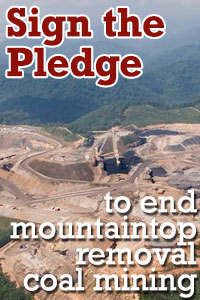iLoveMountains.org is the product of 7 local, state, and regional organizations across Appalachia that are working together to end mountaintop removal and create a prosperous future for the region. Click here to read more about iLoveMountains.org and the organizations that created it.
FREQUENTLY ASKED QUESTIONS ABOUT MOUNTAINTOP REMOVAL
Comments Off on Learn More
Mountaintop removal is a relatively new type of coal mining that began in Appalachia in the 1970s as an extension of conventional strip mining techniques. Primarily, mountaintop removal is occurring in West Virginia, Kentucky, Virginia and Tennessee. Coal companies in Appalachia are increasingly using this method because it allows for almost complete recovery of coal seams while reducing the number of workers required to a fraction of what conventional methods require.
The US Environmental Protection Agency defines mountaintop removal as follows:
“Mountaintop removal/valley fill is a mining practice where the tops of mountains are removed, exposing the seams of coal. Mountaintop removal can involve removing 500 feet or more of the summit to get at buried seams of coal. The earth from the mountaintop is then dumped in the neighboring valleys.”
There are 6 main components of the mountaintop removal process:
 |
CLEARING — Before mining can begin, all topsoil and vegetation must be removed. Because coal companies frequently are responding to short-term fluctuations in the price of coal, these trees are often not even used comercially in the rush to get the coal, but instead are burned or sometimes illegally dumped into valley fills. |
| click to enlarge |
 |
BLASTING — Many Appalachian coal seams lie deep below the surface of the mountains. Accessing these seams through surface mining can require the removal of 500-800 feet or more of elevation. Blowing up this much mountain is accomplished by using millions of pounds of explosives. |
| click to enlarge |
 |
DIGGING — Coal and debris is removed by using this piece of machinery, called a dragline. A dragline stands 22 stories high and can hold 24 compact cars in its bucket. These machines can cost up to $100 million, but are favored by coal companies because they displace the need for hundreds of jobs. . |
| click to enlarge |
 |
DUMPING WASTE — The waste from the mining operation, also known as overburden or spoil, is dumped into nearby valleys, burying streams. According to an EPA environmental impact statement, more than 1,000 miles of Appalachian streams were permitted to be buried as of 2001. |
| click to enlarge |
 |
PROCESSING — The coal is washed and treated before it is loaded on trains. The excess water left over from this process is called coal slurry or sludge and is stored in open coal impoundments. Coal sludge is a mix of water, coal dust, clay and toxic heavy metals such as arsenic mercury, lead, copper, and chromium. Impoundments are held in place by mining debris, making them very unstable. . |
| click to enlarge |
 |
RECLAMATION — While reclamation efforts such as stabilization and revegetation are required for mountaintop removal sites, in practice, state agencies that regulate mining are generous with granting waivers to coal companies. Most sites receive little more than a spraying of exotic grass seed, but even the best reclamation provides no comfort to nearby families and communities whose drinking water supplies have been polluted and whose homes will be threatened by floods for the hundred or thousands of years it will require to re-grow a forest on the mined site. |
| click to enlarge |
No comments yet » Leave your own...















